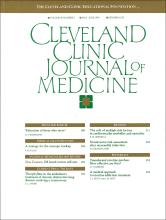Index by author
Snider, Gordon L.
- You have accessTheophylline in the ambulatory treatment of chronic obstructive lung disease: resolving a controversyGordon L. Snider, MDCleveland Clinic Journal of Medicine May 1993, 60 (3) 197-201;
BACKGROUND Recent reports of a high frequency of theophylline toxicity, which usually occurs at theophylline blood levels >20 μg/mL, coupled with the recent addition of metered-dose, inhaled anticholinergics to the beta-2 agonist inhalers already available for treatment of chronic obstructive pulmonary disease, has led some authors to suggest that theophylline should no longer be used in the ambulatory management of this disease.
OBJECTIVE The author suggests an alternate approach to theophylline dosing as a means of resolving the current controversy.
SUMMARY Because of the log-linear relationship between bronchodilation and blood level, little bronchodilator efficacy is lost by using a target therapeutic theophylline blood level of 10 ± 2 μg/mL. This target provides a greater range between therapeutic and toxic blood levels than the 17 ± 2 μg/mL therapeutic target blood level that has also been recommended.
CONCLUSIONS Because theophylline has a different mode of action than the sympathomimetic or anticholinergic drugs, it continues to have a useful place in the ambulatory management of chronic obstructive pulmonary disease.
Stoller, James K.
- You have accessNew feature: IM board review self-testCleveland Clinic Journal of Medicine May 1993, 60 (3) 187;



